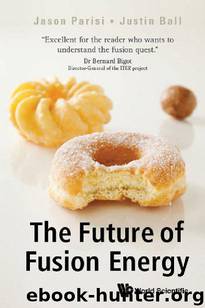The Future of Fusion Energy (Popular Science) by Jason Parisi & Justin Ball

Author:Jason Parisi & Justin Ball [Parisi, Jason & Ball, Justin]
Language: eng
Format: epub
ISBN: 9781786345448
Publisher: World Scientific Europe
Published: 2018-12-30T18:30:00+00:00
The first inkling of practical superconductivity came in 1935, when Ukrainian scientists Rjabinin and Schubnikow discovered a material that exhibited a new kind of superconductivity. These materials were inventively named type II superconductors in order to distinguish them from the existing superconductors, which became known as type I. While type I materials suddenly and entirely lose their superconducting ability when any of the three operating limits is violated, type II materials exhibit a gradual transition. At the start of this transition, only small regions in the material lose superconductivity, which the electric current can simply go around. This means that type II superconductors remain resistivity-free over a much broader range of operating conditions. Early type II superconductors were used to construct coils that generated 1 Tesla magnetic fields. While this was encouraging, the real breakthrough for fusion came in 1961. Scientists at the Bell Telephone Laboratory discovered that a niobium–tin compound, a type II superconductor, was capable of functioning in fields exceeding 10 Tesla (see Figure 6.3). Niobium–tin, along with a similar niobium–titanium compound, have since become the workhorses of applied superconductivity. Niobium–titanium is cheaper and more robust, but niobium–tin can achieve higher magnetic fields.
Progress in superconductivity is enormously useful for fusion, but there is typically a substantial delay between discovery and implementation (see Figure 6.4). Every step from the discovery of a superconducting material, to producing macroscopic quantities of it, to engineering mechanically strong wires, is a challenge that holds the possibility of failure. Hundreds of superconducting compounds have been identified, yet only a few are practical. So it isn’t surprising that the first fusion device to use superconducting magnets, the T-7 tokamak at the Kurchatov Institute in Moscow, wasn’t built until 1979 — almost 70 years after the discovery of superconductivity. It used toroidal field magnets made of niobium–titanium to generate a 3 Tesla field. The first tokamak to use the more ambitious niobium–tin superconductor was TRIAM-1M in Japan, which had an impressive field strength of 8 Tesla. However, it wasn’t built until 1986, 25 years after the superconducting properties of niobium–tin were first observed.
Download
This site does not store any files on its server. We only index and link to content provided by other sites. Please contact the content providers to delete copyright contents if any and email us, we'll remove relevant links or contents immediately.
The Complete Stick Figure Physics Tutorials by Allen Sarah(7335)
Secrets of Antigravity Propulsion: Tesla, UFOs, and Classified Aerospace Technology by Ph.D. Paul A. Laviolette(5330)
Thing Explainer by Randall Munroe(3905)
The River of Consciousness by Oliver Sacks(3571)
The Order of Time by Carlo Rovelli(3162)
How To by Randall Munroe(3074)
A Brief History of Time by Stephen Hawking(2991)
I Live in the Future & Here's How It Works by Nick Bilton(2958)
What If?: Serious Scientific Answers to Absurd Hypothetical Questions by Randall Munroe(2667)
The Great Unknown by Marcus du Sautoy(2661)
Midnight in Chernobyl by Adam Higginbotham(2515)
Blockchain: Ultimate Step By Step Guide To Understanding Blockchain Technology, Bitcoin Creation, and the future of Money (Novice to Expert) by Keizer Söze(2465)
Networks: An Introduction by Newman Mark(2382)
The Meaning of it All by Richard Feynman(2318)
Easy Electronics by Charles Platt(2307)
The Tao of Physics by Fritjof Capra(2247)
Midnight in Chernobyl: The Untold Story of the World's Greatest Nuclear Disaster by Adam Higginbotham(2195)
When by Daniel H Pink(2098)
Introducing Relativity by Bruce Bassett(2097)
